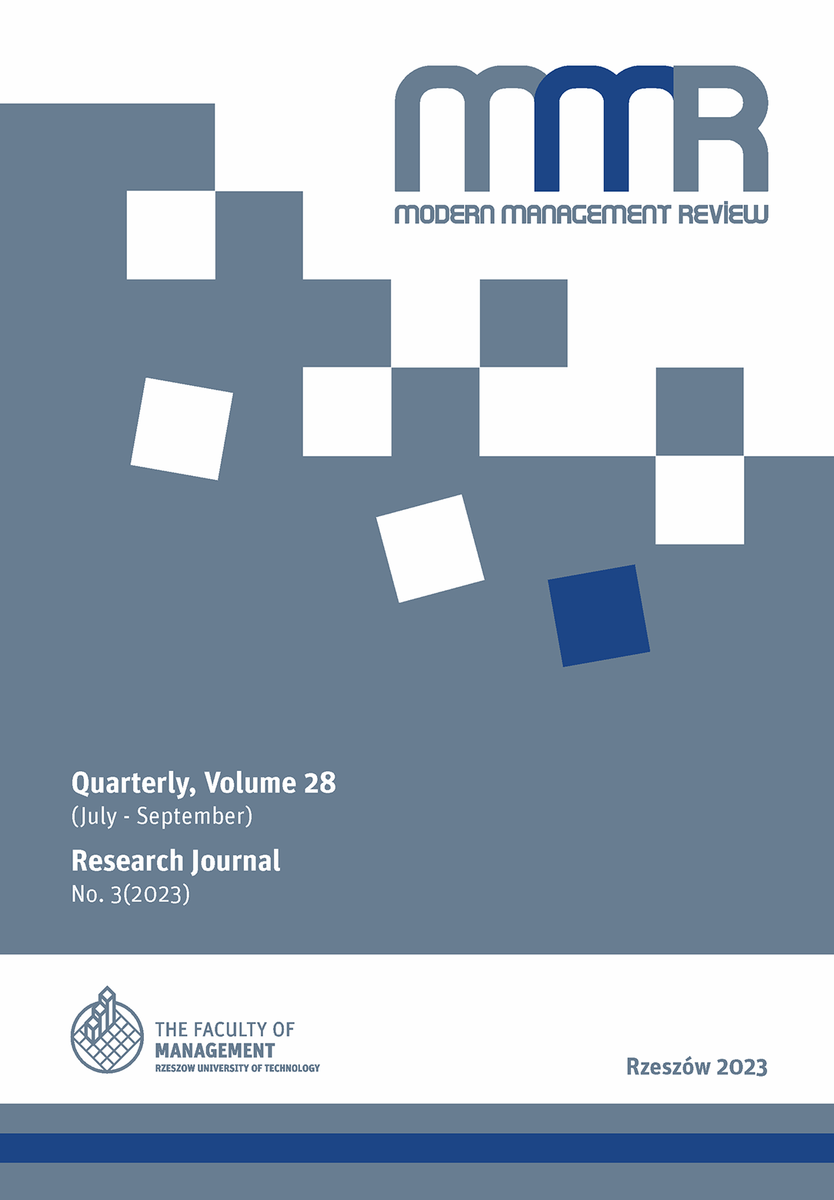Abstrakt
The proliferation of the Internet, as well as its utilization as a marketing tool, has led to
a shift in traditional distribution channels from street-side stores to e-commerce. It is, therefore, essential to conduct in-depth research regarding the scope of e-commerce usage in order to develop a more efficient marketing strategy for retail entities. This paper aims to explore the parameters for a culture-driven marketing strategy in Kazakhstan, a country that is characterized by a high uncertainty avoidance culture. A qualitative data collection (n=250) for cross-sectional analysis of retail enterprises in Kazakhstan was conducted to identify cultural differences that may affect customers’ perception of marketing and logistics. This survey was divided into four main categories and the results of trust-based marketing strategies were analyzed through multiple regressions, t-tests and 95% confidence interval for p-value estimations. The findings revealed the lack of interest in the transparency level of the grocery retailers, as well as an inclination towards cash-on-delivery methods in risk aversive cultures.
Bibliografia
Al-Adwan, A.S., Al-Debei, M.M., Dwivedi, Y.K. (2022). E-commerce in high uncertainty avoidance cultures: The driving forces of repurchase and word-of-mouth intentions. “Technology in Society”, 71. DOI: 10.1016/j.techsoc.2022.102083.
Atkinson, R., Shiffrin, R. (1968). Human Memory: A Proposed System and its Control Processes. “Psychology of Learning and Motivation”. DOI: 10.1016/s0079-7421(08)60422-3.
Bawa, K., Shoemaker, R.W. (1989). Analyzing Incremental Sales from a Direct Mail Coupon Promotion. “Journal of Marketing”, 53(3). DOI: 10.1177/002224298905300308.
Benslimane, Y., Yang, Z. (2007). Linking commercial website functions to perceived usefulness: A free disposal hull approach. “Mathematical and Computer Modelling”, 46(9–10). DOI: 10.1016/j.mcm.2006.12.008.
Calisir, F., Elvan Bayraktaroğlu, A., Altin Gumussoy, C., İlker Topcu, Y., Mutlu, T. (2010). The relative importance of usability and functionality factors for online auction and shopping web sites. “Online Information Review”, 34(3). DOI: 10.1108/
Carlo Bertot, J., Snead, J.T., Jaeger, P.T., McClure, C.R. (2006). Functionality, usability, and accessibility: Iterative user‐centered evaluation strategies for digital libraries. “Performance Measurement and Metrics”, Vol. 7 No. 1. DOI: 10.1108/14678040610654828
Chang, M.K., Cheung, W., Tang, M. (2013). Building trust online: Interactions among trust building mechanisms. “Information &Amp; Management”, 50(7). DOI: 10.1016/j.im.2013.06.003.
Cho, J.E., Hu, H. (2009). The effect of service quality on trust and commitment varying across generations. “International Journal of Consumer Studies”, 33(4). DOI: 10.1111/j.1470-6431.2009.00777.x.
Cui, D., Curry, D. (2005). Prediction in Marketing Using the Support Vector Machine. “Marketing Science”, 24(4). DOI: 10.1287/mksc.1050.0123.
Diamantopoulos, A., Schlegelmilch, B.B., Sinkovics, R.R., Bohlen, G.M. (2003). Can socio-demographics still play a role in profiling green consumers? A review of the evidence and an empirical investigation. “Journal of Business Research”, 56(6). DOI: 10.1016/s0148-2963(01)00241-7.
Dong, X., Manchanda, P., Chintagunta, P.K. (2009). Quantifying the Benefits of Individual-Level Targeting in the Presence of Firm Strategic Behavior. “Journal of Marketing Research”, 46(2). DOI: 10.1509/jmkr.46.2.207.
Ganesan, S. (1994). Determinants of Long-Term Orientation in Buyer-Seller Relationships. “Journal of Marketing”, 58(2). DOI: 10.1177/002224299405800201.
Garcia, J.M., Freire, O.B.D.L., Santos, E.B.A., Andrade, J. (2020). Factors affecting satisfaction and loyalty to online group buying. “Revista De Gestão”, 27(3). DOI: 10.1108/rege-02-2018-0037.
Gawor, T., Hoberg, K. (2019). Customers’ valuation of time and convenience in e-fulfillment. “International Journal of Physical Distribution &Amp; Logistics Management”, 49(1). DOI: 10.1108/ijpdlm-09-2017-0275.
Gundersen, M. (1996). Hotel guest satisfaction among business travelers What are the important factors? “The Cornell Hotel and Restaurant Administration Quarterly”, 37(2). DOI: 10.1016/0010-8804(96)83104-1.
Guo, X., Ling, K.C., Liu, M. (2012). Evaluating Factors Influencing Consumer Satisfaction towards Online Shopping in China. “Asian Social Science”, 8(13). DOI: 10.5539/ass.v8n13p40.
Hamed, S., El-Deeb, S. (2020). Cash on Delivery as a Determinant of E-Commerce Growth in Emerging Markets. “Journal of Global Marketing”, 33(4). DOI: 10.1080/08911762.2020.
Harris, P., Dall’Olmo Riley, F., Riley, D., Hand, C. (2017). Online and store patronage: a typology of grocery shoppers. “International Journal of Retail &Amp; Distribution Management”, 45(4). DOI: 10.1108/ijrdm-06-2016-0103.
Hofstede, G. (1991). Cultures and Organizations: Software of the Mind: Intercultural Cooperation and Its Importance for Survival. New York: McGraw-Hill.
Hood, N., Urquhart, R., Newing, A., Heppenstall, A. (2020). Sociodemographic and spatial disaggregation of e-commerce channel use in the grocery market in Great Britain. “Journal of Retailing and Consumer Services”, 55. DOI: 10.1016/j.jretconser.2020.
Ibrahim, B., Aljarah, A. (2018). Dataset of relationships among social media marketing activities, brand loyalty, revisit intention. Evidence from the hospitality industry in Northern Cyprus. “Data in Brief”, 21. DOI: 10.1016/j.dib.2018.11.024.
Islam, T., Meade, N., Carson, R.T., Louviere, J.J., Wang, J. (2022). The usefulness of socio-demographic variables in predicting purchase decisions: Evidence from machine learning procedures. “Journal of Business Research”, 151. DOI: 10.1016/j.jbusres.2022.07.004.
Janakiraman, N., Syrdal, H.A., Freling, R. (2016). The Effect of Return Policy Leniency on Consumer Purchase and Return Decisions: A Meta-analytic Review. “Journal of Retailing”, 92(2). DOI: 10.1016/j.jretai.2015.11.002.
Kim, S., Stoel, L. (2004). Apparel retailers: website quality dimensions and satisfaction. “Journal of Retailing and Consumer Services”, 11(2). DOI: 10.1016/s0969-6989(03)00010-9.
Kotler, P. (2003). Marketing Management (11th Edition). PRENTICE HALL.
Loureiro, S.M., Cavallero, L., Miranda, F.J. (2018). Fashion brands on retail websites: Customer performance expectancy and e-word-of-mouth. “Journal of Retailing and Consumer Services”, 41. DOI: 10.1016/j.jretconser.2017.12.005.
Mehrabian, A., Russell, J.A. (1974). An approach to environmental psychology. the MIT Press.
Meilatinova, N. (2021). Social commerce: Factors affecting customer repurchase and word-of-mouth intentions. “International Journal of Information Management”, 57. DOI: 10.1016/j.ijinfomgt.2020.102300.
Oralova, S.S. (2022). The Main Trends in the Formation of the Internet Space and Information Society in Kazakhstan. “Economics: The Strategy and Practice”, 17(1). DOI: 10.51176/1997-9967-2022-1-50-61.
Özdemir, A., Tozlu, E., Şen, E., Ateşoğlu, H. (2016). Analyses of Word-of-mouth Communication and its Effect on Students’ University Preferences. “Procedia – Social and Behavioral Sciences”, 235. DOI: 10.1016/j.sbspro.2016.11.022.
Развитие e-commerce в РК [Development of e-commerce in Kazakhstan] (2022). Forbes Kazakhstan. Access on the internet: https://forbes.kz//finances/markets/razvitie_e-commerce_v_kazahstane_summa_zakazov_vyirosla_v_3_raza_za_proshloe_polugodie/?
Restuputri, D.P., Indriani, T.R., Masudin, I. (2021). The effect of logistic service quality on customer satisfaction and loyalty using kansei engineering during the COVID-19 pandemic. “Cogent Business &Amp; Management”, 8(1). DOI: 10.1080/23311975.2021.1906492.
Safa, N.S., Von Solms, R. (2016). Customers repurchase intention formation in e-commerce. “SA Journal of Information Management”, 18(1). DOI: 10.4102/sajim.v18i1.712.
Samorani, M., Alptekinoğlu, A., Messinger, P.R. (2019). Product Return Episodes in Retailing. “Service Science”, 11(4). DOI: 10.1287/serv.2019.0250.
Seffah, A., Mohamed, T., Habieb-Mammar, H., Abran, A. (2008). Reconciling usability and interactive system architecture using patterns. “Journal of Systems and Software”, 81(11). DOI: 10.1016/j.jss.2008.04.037.
Tandon, U., Kiran, R., Sah, A.N. (2016). Understanding Online Shopping Adoption in India: Unified Theory of Acceptance and Use of Technology 2 (UTAUT2) With Perceived Risk Application. “Service Science”, 8(4). DOI: 10.1287/serv.2016.0154.
—— (2017). The influence of website functionality, drivers and perceived risk on customer satisfaction in online shopping: an emerging economy case. “Information Systems and E-Business Management”, 16(1). DOI: 10.1007/s10257-017-0341-3.
Verma, S., Sharma, R., Deb, S., Maitra, D. (2021). Artificial intelligence in marketing: Systematic review and future research direction. “International Journal of Information Management Data Insights”, 1(1), 100002. DOI: 10.1016/j.jjimei.2020.100002.
Wolfinbarger, M., Gilly, M.C. (2003). eTailQ: dimensionalizing, measuring and predicting etail quality. “Journal of Retailing”, 79(3). DOI: 10.1016/s0022-4359(03)00034-4.
Xing, Y., Grant, D.B., McKinnon, A.C., Fernie, J. (2010). Physical distribution service quality in online retailing. “International Journal of Physical Distribution &Amp; Logistics Management”, 40(5). DOI: 10.1108/09600031011052859.
Zhussupova, A. (2021, May 10). Медиапотребление в Казахстане: Интернет и соц сети побеждают: Media consumption in Kazakhstan: The Internet and social networks win. “Ekonomist.Kz.”. Access on the internet: https://ekonomist.kz/zhussupova/mediapotreblenie-kazahstan-2020-internet/.
Zwick, C. (1957). Demographic Variation: Its Impact on Consumer Behavior. “The Review of Economics and Statistics”, 39(4). DOI: 10.2307/1927015.

Utwór dostępny jest na licencji Creative Commons Uznanie autorstwa – Użycie niekomercyjne – Bez utworów zależnych 4.0 Międzynarodowe.
Copyright (c) 2023 Modern Management Review


